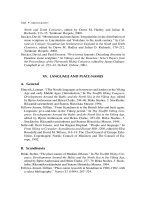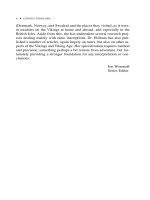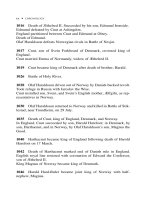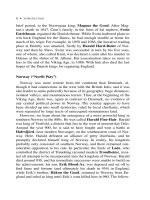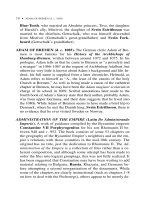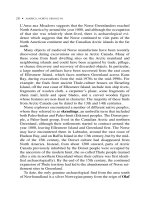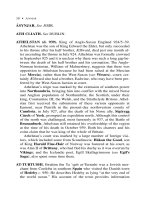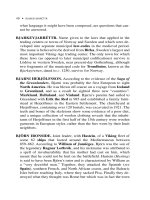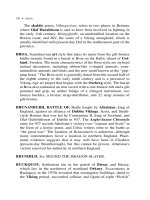The A to Z of the Vikings 8 doc
Bạn đang xem bản rút gọn của tài liệu. Xem và tải ngay bản đầy đủ của tài liệu tại đây (68.21 KB, 10 trang )
what language it might have been composed, are questions that can-
not be answered.
BJARKEYJARRÉTTR. Name given to the laws that applied in the
trading centers or towns of Norway and Sweden and which were de-
veloped into separate municipal law-codes in the medieval period.
The name is believed to be derived from Birka, Sweden’s largest and
most important Viking-Age trading center. The only town for which
these laws (as opposed to later municipal codifications) survive is
Lödöse in western Sweden, near present-day Gothenburg, although
two fragments of the municipal code for Trondheim, known as the
Bjarkøyretten, dated to c. 1250, survive for Norway.
BJARNI HERJÓLFSSON. According to the evidence of the Saga of
the Greenlanders, Bjarni was probably the first European to sight
North America. He was blown off course on a voyage from Iceland
to Greenland, and as a result he sighted three new “countries”:
Markland, Helluland, and Vinland. Bjarni’s parents had sailed to
Greenland with Erik the Red in 985 and established a family farm-
stead at Herjolfsnes in the Eastern Settlement. The churchyard at
Herjolfsnes, containing over 120 burials, was excavated in 1921. The
teeth and bones of the skeletons show some evidence of a poor diet,
and a unique collection of woolen clothing reveals that the inhabi-
tants of Herjolfsnes in the first half of the 15th century wore woolen
garments in European styles, rather than the furs worn by their Inuit
neighbors.
BJÖRN IRONSIDE. Joint leader, with Hastein, of a Viking fleet of
some 62 ships that looted around the Mediterranean between
859–862. According to William of Jumièges, Björn was the son of
the legendary Ragnar Lo
ðð
brók, and his nickname was attributed to
a spell of invulnerability that his mother had cast on him, which
meant that he could not be hurt on the battlefield. Hastein (Hasting)
is said to have been Björn’s tutor and is characterized by William as
a “very deceitful man.” Together, they attacked the Spanish (see
Spain), southern French, and North African coasts, and the Balearic
Isles before reaching Italy, where they sacked Pisa. Finally they de-
stroyed what they thought was Rome but which was in fact the town
48 • BJARKEYJARRÉTTR
of Luna, some 300 kilometers to the north of Rome. They returned to
their base on the Loire in France in 862, and Björn later died in Frisia
after being shipwrecked off the English coast. Although the Annals
of St-Bertin do mention a Viking leader called Björn, who swore an
oath of fidelity to Charles the Bald in 858, William of Jumièges’s
account of Björn seems to owe more to fiction than to fact.
BJÖRN, KING. Rimbert’s Life of St. Ansgar records that Björn was
king of the Svear (see Svealand) in the late 820s and that he wel-
comed Ansgar’s mission to Birka.
BLOOD-EAGLE (ON bló
ðð
örn). This gory rite is said to have been in-
flicted upon Ælla of Northumbria in 867 by the Viking, Ivar the
Boneless, as revenge for Ælla killing his father, the legendary Ragnar
Lo
ðð
brók. Descriptions of the blood-eagle are first found in the late
12th century and are associated with two historical figures (Ælla and
Halfdan), as well as with two mythical figures (Lyngvi and Brusi). A
recent suggestion that St. Edmund of East Anglia may have been the
victim of the blood-eagle is unconvincing. Although there is some
variation in the details, the “classic,” most lurid, version of the blood-
eagle involved the ribs being torn from the spine and the lungs being
pulled out through an eagle-shaped cut on the victim’s back.
The first extant reference to this ritual killing, and the only Viking-
Age evidence for the blood-eagle, is a half stanza of the skaldic poem
Knútsdrápa, composed by Sighvatr
þþ
ór
ðð
arson. This has been tradi-
tionally interpreted as: “Ivar had Ælla’s back incised with an eagle”
and seems to be the source of later Scandinavian accounts about the
ritual. However, this interpretation has been challenged as a too lit-
eral interpretation of the poem, suggesting instead that Ælla’s back
was cut by an eagle, one of the carrion birds that circled battlefields;
in other words, he was killed (in an otherwise unspecified manner).
Certainly the highly elliptical nature of Sighvatr’s poetry makes it
open to misinterpretation.
BÓNDI (plural bændr). ON noun with the primary meaning of “head of
the household.” In the predominately agricultural and rural society
of Viking-Age Scandinavia, this word is often used in the sense of
“farmer, a person who owned a farm,” but it is also frequently found
BÓNDI •49
on Viking-Age rune-stones (see rune) with the meaning of “husband.”
Later on, in the medieval period, with the development of towns and
trade, the word also took on a more general meaning of “someone who
owned land or property (in the town),” and thus “landlord” or
“burgher.” In the Icelandic law-codes, each bóndi was required to join
the following of a chieftain (see go
ðð
i) and to accompany him to the
springtime assembly and to either pay a thing-attendance tax or to at-
tend the Althing with their chieftain each summer. These laws also
stated that a bóndi could choose which chieftain to follow and that he
was allowed to change chieftains as often as once every year. The Ed-
dic poem Rígs
þþ
ula includes a reference to a man called Bóndi, who
was one of the sons of the free farmer, Karl.
BOOK OF THE ICELANDERS (ON Íslendingabók). A short history
of Iceland, from its settlement circa 870 until 1118, composed by
Ari Thorgilsson between 1122 and 1132. This is the first extant
history of Iceland and it is also significant as it is composed in Ice-
landic, not Latin. The Book of Icelanders records the settlement of
Iceland; the establishment of the Icelandic national assembly, the
Althing; the development of the Icelandic law-codes and adminis-
tration; and the discovery and settlement of Greenland. However
most space is devoted to a discussion of the conversion of Iceland
to Christianity and the early history of the Icelandic church. Ari
refers to a number of his sources, the majority of which are old and
trustworthy people, such as Teit, Ari’s foster-father and son of
Bishop Isleif; Thorkel Gellison, Ari’s uncle; and Thurid, daughter
of Snorri go
ðð
i.
BOOK OF THE MEASUREMENT OF THE EARTH (Liber de
mensura orbis terræ). Latin work written by the Irish monk,
Dicuil, in France c. 825. Dicuil writes that monks had visited and
settled on various islands to the north and northwest of the British
Isles, presumably in the North Atlantic. He provides brief descrip-
tions of what appear to be the Faroe Islands, apparently inhabited
by Irish hermits for about 100 years, and “Thule,” which has been
identified with Iceland. In his account of “Thule,” Dicuil states ex-
plicitly that his source was the accounts of priests (clerici) who had
lived there 30 years before he was writing.
50 •
BOOK OF THE MEASUREMENT OF THE EARTH
Today, the Book of Icelanders survives in two 17th-century
copies of a lost codex from c. 1200. According to his preface, Ari
had written an earlier version of this work, and the version we have
is his revised version, following suggestions by Bishop Thorlak of
Skálholt (descended from Aud the Deep-Minded) and Bishop
Ketill of Holar (descended from Helgi the Lean), and Sæmund the
Learned.
BOOK OF SETTLEMENTS (ON Landnámabók). Probably compiled
by Ari Thorgilsson in the early 12th century, this work includes a de-
tailed account of the land taken by the original settlers
of Iceland, organized topographically by the four quarters into which
Iceland was divided, as well as comprehensive genealogies of these
settlers. In all, some 430 different settlers, 3,500 personal names, and
1,500 farm names are recorded in this work, which made it an ex-
tremely useful source for later saga writers.
In total, there are five different redactions of Landnámabók: three
were written or compiled in the medieval period and two were compiled
in the 17th century. Sturlubók is attributed to Sturla
þ
órðarson (d. 1284)
but the only extant version of this redaction is found in a 17th-century
manuscript; Hauksbók is the work of Haukr Erlendson (d. 1334), writ-
ten between 1306–1308, but it too is only found in a 17th-century man-
uscript. Haukr seems to have used Sturlubók and an older, now lost,
version called Styrmisbók; Melabók was written at the beginning of the
14th century. This is actually preserved in the oldest manuscript, but it
is unfortunately only fragmentary; Skar
ð
sárbók is a 17th-century com-
pilation based on Hauksbók and Sturlubók; and finally
þ
ór
ð
arbók is an-
other 17th-century compilation, but based on Skar
ð
sárbók and
Melabók.
BORG. High-status settlement on the island of Vestvågøy, Lofoten,
northern Norway. Although Borg lies well north of the Arctic Circle,
archaeological work in the area has revealed that there was relatively
dense settlement in the area during the Iron Age and Viking Age. In
Lofoten, the climate was relatively mild, warmed by the Gulf Stream,
and there was good fishing and good grazing for cattle. From the is-
land of Vestvågøy alone, about 1,000 graves, 50 boathouses, and 18
farms are known from this period.
BORG •51
Borg itself enjoyed a protected harbor and a good view of the sur-
rounding countryside. The Viking-Age structures from Borg include
the remains of a chieftain’s hall that was 83 meters long, dating to the
eighth or ninth century, three boathouses, and a circular courtyard be-
lieved to have housed the chieftain’s men. Luxury items from the site
include pottery and glass from western Europe and two gold foil fig-
ures (Norwegian gullgubbe), believed to depict the god Frey and the
giantess Gerd, that have a cultic significance. Finds of this nature are
normally associated with Scandinavian trading centers, such as Kau-
pang, Helgö, Birka, and Hedeby. However, the majority of the finds
were of an everyday character and suggest that farming and fishing
were the most important economic activities at Borg.
BORNHOLM. Island in the Baltic Sea, which today is part of Den-
mark. However, an account of a journey from Hedeby to Truso by
the English merchant, Wulfstan, preserved in King Alfred the
Great’s translation of Orosius’ Seven Books of History against
the Pagans, records that the island (Burgenda land) had its own king.
Culturally, the island is distinct from Denmark in a number of ways:
for example, Viking-Age rune-stones (see rune) continued to be
raised on Bornholm after the custom ceased to be popular in Den-
mark at the end of the 10th century, and their design has more in com-
mon with Swedish rune-stones than Danish.
BORRE. Scandinavian art style that takes its name from the artifacts
found in the burials at Borre, Vestfold, in southeast Norway. The ceme-
tery at Borre contains nine large and a number of smaller burial mounds,
and two cairns, making it the largest group of high-status burial
mounds in Scandinavia. The burial mounds at Borre are believed to be
those of the Viking-Age kings of Norway, and references in skaldic po-
etry, such as
þ
jó
ð
ólfr of Hvin’s stanza quoted in Ynglinga Saga, sub-
stantiate the royal nature of the site. However, two of the large mounds
have recently been given C14 dates in the seventh century, suggesting
that the site was important before, as well as during, the Viking Age. The
first mound was uncovered in the mid-19th century, when a gravel pit
was dug. The remains of a ship, some 17 meters long, was found, along
with a number of grave goods, the most important of which were the
gilt-bronze harness mounts that gave the Borre art style its name.
52 • BORNHOLM
The main characteristics of the Borre style are the so-called “grip-
ping beast” motif and the ring-chain interlaced pattern. The Borre
style was current from the mid-9th to the mid-10th century in Scan-
dinavia, and is also found on artifacts from Iceland, the British Isles,
Ireland, and Russia.
BRAAID, THE. Settlement in Marown parish on the Isle of Man, con-
sisting of two longhouses, one of which measured a massive 21 me-
ters by 9 meters and was constructed with large stone slabs. The
smaller of the longhouses is interpreted as a stable or byre for live-
stock. The site is particularly interesting as a roundhouse. Built in the
traditional Manx style, it stands adjacent to the typically “Scandina-
vian” longhouses. It is possible that the “Scandinavian” and “Manx”
houses were occupied concurrently for a brief period, although the
lack of diagnostic artifacts makes it impossible to discuss the ques-
tion of interaction between Scandinavian and Manx cultures and pop-
ulations on the site.
BRACTEATES. Disks of thin gold produced in Scandinavia during the
fifth and sixth centuries that were originally imitations of Late Ro-
man and Byzantine medallions showing the emperor’s head. They
were stamped with decoration, usually a central picture and sur-
rounding patterns, on just one side, and had a loop so that they could
be worn as pendants around the neck. Over 100 of these bracteates
also have inscriptions in the older, 24-letter runic alphabet (see
runes). Many of these runic letters are upside-down or backward fac-
ing, and although this has been traditionally interpreted as a sign of
illiteracy among the gold-smiths who produced the bracteates, the
problems of cutting an inscription in reverse in a die may account for
a substantial number of these “mistakes.” The well-known magical
words alu “luck,” laukaR “fertility, prosperity?” (“leek”), and auja
“well-being” are the most commonly occurring words found in these
bracteate inscriptions.
BRAGI. God of the Æsir who, according to the Prose Edda, was the
god of poetry. He was married to the goddess, Idun, but otherwise
very little is known about him and he is very rarely mentioned in Ed-
dic or skaldic poetry. It seems likely that the god was in fact created
BRAGI •53
by medieval writers from a historical figure, Bragi Boddason (also
known as Bragi the Old), a ninth-century skald. In the medieval Skál-
datal (“List of Skalds”), Bragi is said to have served at the court of
the Swedish king Björn, who was visited by St. Ansgar. The Prose
Edda contains some 20 stanzas of Ragnarsdrápa, a poem composed
by Bragi that describes various mythological scenes that were de-
picted on a shield.
BRATTAHLÍD
–
(Inuit Qagssiarssuk). Site on Eiriksfjörd, Eastern Set-
tlement in Greenland, where Erik the Red built his farm at the end of
the 10th century. In addition to being the political center of the Eastern
Settlement, one of the earliest churches in Greenland was built at Brat-
tahlí
ð by Erik’s wife, Thjodhild. This turf structure and its associated
graveyard, lying some distance from the 14th-century stone church that
is visible today on the site, have been excavated by archaeologists. The
graveyard contained an unusual mass grave near the south wall con-
sisting of the disarticulated skeletons of some 13 males who had ap-
parently been buried simultaneously. The remains of three different
farms and a thing place can also still be seen at Brattahlí
ð. Brattahlíð
is still one of the best locations for farming in Greenland.
BREVIS HISTORIA REGUM DACIE (“Short History of the Kings
of Denmark”). Twelfth-century history of Denmark written by Sven
Aggesen, possibly c. 1188, which begins with the first king of Den-
mark, Skjöld, and concludes in 1185, with the submission of
Bugislav, prince of Pomerania, to Knut VI (d. 1202) of Denmark fol-
lowing the naval victory at Stralsund. As well as detailing the ge-
nealogy of the kings of Denmark and summarizing some 35 reigns,
Sven’s history incorporates longer sections of narrative that include
two anti-German stories: the legend of Uffi, who defeated the Ger-
mans, and Queen Thyre’s rejection of the German emperor, Otto. A
lost genealogy, which Sven refers to, was originally appended to the
History. Although Sven claims to have used old traditions and
the stories of “aged men” in compiling his history, it seems that this
was largely authorial rhetoric; certainly most of his information can
be traced to written sources. As well as referring to the work of Ice-
landers, Sven was clearly versed in classical and biblical learning and
cites, amongst others, Virgil, Ovid, and Lucan.
54 • BRATTAHLÍD
–
The Short History is preserved in two manuscript traditions (des-
ignated A and S), along with another of his works, the Law of the
Hird (see hird) or Vederlov. Unfortunately, both traditions are prob-
lematic: A is an often unintelligible copy of a lost medieval manu-
script made around 1570, and S is an amended copy of a lost
medieval manuscript, made in the late 13th century; this 13th-century
copy was in turn “corrected” by Stephan J. Stephanius for the first
printed edition of Sven’s works, made in the 17th century. Unfortu-
nately, the 13th-century copy was destroyed in a fire in Copenhagen
in 1728, and it is now impossible to separate Stephanius’s amend-
ments from those of the medieval scribe.
BRIAN BORU (Irish Brian Bóraime “of the tributes”) (926–1014).
High king of Ireland on his death at the Battle of Clontarf in 1014,
Brian was the son of Cénneteig and the brother of King Mathgamain
of the kingdom of Dál Cais (later known as Uí Briain). His family
lands lay in Munster, western Ireland, along the lower reaches of the
River Shannon, close to the Viking port of Limerick. Following
the murder of Mathgamain in 976, Brian succeeded to his kingdom
and immediately resumed Mathgamain’s campaign against the
Vikings of Limerick: he killed Ímar, king of Limerick, and his two
sons in 977, and he defeated the Vikings of Limerick and their allies
in battle in 978. Brian then set about extending his power in Ireland,
actions that brought him into direct conflict with Máel Sechnaill II,
high king of the Southern Uí Néill, who had himself waged war on
the Norse (of Dublin). Following a series of territorial conquests
by Brian, this struggle was resolved in 997, when Máel Sechnaill and
Brian came to terms. As a result of this settlement, Máel Sechnaill re-
ceived the northern half of Ireland and Brian the southern half. Brian
thus became lord of Dublin and Leinster but was faced by a revolt in
999. However, the rebellion was soon quashed: the king of Leinster
was held hostage until his submission, Dublin was burned, and its
king, Sigtrygg Silk-Beard fled, before finally recognizing Brian’s
overlordship. With the troops, fleet and taxes of Dublin behind him,
Brian felt confident enough to break his alliance with Máel Sechnaill.
By 1005, Brian claimed to be high king of all Ireland, although in re-
ality his effective control of northern Ireland should probably be
dated to 1011. In Viking history, however, Brian is most famous for
BRIAN BORU (926–1014) •55
his part in the Battle of Clontarf, in which he was killed; a lost saga,
Brjáns Saga, was later written about the king’s death in this battle.
Following the battle, Donnchad, Brian’s son, led the remnants of his
army home and Brian’s body was taken to Armagh; Máel Sechnaill
was restored as high king. Brian’s posthumous reputation owes much
to the 12th-century work of Uí Briain propaganda, Cogadh Gaedhel
re Gallaibh the “War of the Irish with the Foreigners.”
BRÍSINGAMEN. Necklace that belonged to the goddess Freya, but
which was stolen from her by Loki according to Snorri’s Prose Edda
and the skaldic poem, Húsdrápa (which was one of Snorri’s
sources). According to Húsdrápa, Loki and Heimdall became seals
and fought for the necklace at a place called Singasteinn. Otherwise
very little is known about this myth, apart from a late 14th-century
source, Sörli
þ
áttr, the authenticity of which is doubtful. The Old
English poem, Beowulf, refers to a necklace, Brosinga mene, which
is said to have been stolen from Eormenric by Hama.
BRITTANY. The province of Brittany in the northwest of present-day
France was inhabited by a Celtic population and was only incorpo-
rated into the Carolingian Empire at the very end of the eighth cen-
tury. There were a number of Carolingian expeditions against the
province in the early ninth century. Louis the Pious appointed a Bre-
ton called Nominoe to rule the province on his behalf, but after
Louis’s death in 840, Nominoe once more asserted Brittany’s inde-
pendence from the rulers of Frankia, sometimes siding with Vikings
against the emperors. Nevertheless, the province suffered from
Viking attacks from the beginning of the ninth century, and one of the
most important Viking bases was situated on Breton territory, on
the island of Noirmoutier at the mouth of the River Loire, near the
provincial capital of Nantes. The monks who had inhabited this is-
land constructed a fortification to defend themselves against raids,
but finally left with the relics of their patron, St. Philibert, in 836 ac-
cording to Ermentarius of Noirmoutier.
In 843 the so-called Loire Vikings started to overwinter on Noir-
moutier, and there was an intensification of Viking activity in Brit-
tany and Frankia in general. In 847, Nominoe appears to have paid
off the Vikings, and their fleet moved south to raid Aquitaine. Shortly
56 • BRÍSINGAMEN
afterward, in 853, his son and successor, Erispoe, came to terms with
a group of Vikings under Sidroc, and in the following year their com-
bined forces attacked, unsuccessfully, the Danish army of Godfred
that was encamped on the Ile de Bièce in the Loire. The second half
of the ninth century saw more Breton alliances and deals with the
Vikings, sometimes in opposition to the rulers of Frankia who sought
to extend their own influence in Brittany and who also used Viking
armies to help them in their campaigns. Civil war in Brittany after the
death of its leader, Salomon, in 874, led to more alliances and coun-
teralliances between different factions and to more Viking attacks.
However, by 892, Alain of Vannes (also known as Alain the Great)
had cleared the Viking armies from Brittany, and most of
the Great Army left for England, signaling a period of peace for the
province.
The death of Alain the Great in 907 marked the beginning of a
yet more intensive period of Viking attacks on the province, at the
same time as a Scandinavian colony was established in neighboring
Normandy. Viking armies campaigned in Brittany from 912 and a
Norwegian army led by Rögnvald took control of the province in
919, prompting many of its nobility and clergy to flee to the safety
of the English court of Athelstan. Although Viking control of Brit-
tany lasted over 20 years, virtually nothing is known about this pe-
riod. There is no archaeological evidence that the warriors settled
down and began to make their living from farming and trading, as
was the case in the Danelaw and Normandy, and the capital,
Nantes, appears to have fallen into ruin during the occupation. In-
deed the limited archaeological evidence from the province sug-
gests that the new overlords resolutely refused to change their
Viking ways: four swords have been found, by chance, in the River
Loire; two monasteries show evidence of 9th- or 10th-century de-
struction that is consistent with Viking attacks; there is a 10th-
century pagan ship burial from the Île de Groix; a 10th-century fort
from Camp de Péran; and a small number of other, unexcavated,
earthworks that may represent Viking strongholds. A Breton rebel-
lion was put down in 931, and shortly afterward, the grandson of
Alain the Great, Alain Barbetorte, launched an English-backed in-
vasion of Brittany in 936 and succeeded in restoring Breton control
of the province three years later.
BRITTANY •57
